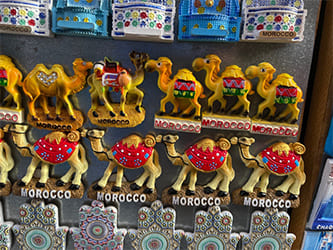
My mission to find a dragon felt like it failed right out of the gate. My desire for the unknown land of Morocco to be as mysterious and otherworldly as the Arabian Nights was a childish fantasy, and I was immediately snapped out of a naïve wish for my experiences there to amount to some “Desert Dragon” tale. The towns were far from mysterious; people haphazardly occupied the roads, their trash littering the streets, and feral cats and dogs feasting on the dumping grounds. I was shocked to see fish sitting directly on the side of the road for sale, but even shops went for sheer volume over any kind of aesthetic or visual clarity in displaying their wares. Foreigners were an easy mark, pushed and cajoled into buying anything the merchants could sell—single shoes were lined up on the streets! It’s a tough life here, with even children pushed into hawking wares. Probably the only things that matched my preconception of the place were the Quran passages echoing through the streets and the fragrant spices drifting through the dry air. I clung to those wisps of exoticism as I walked through the town, but I never did find my dragon.

Unique ways of displaying fashion goods

Shops absolutely stuffed with products

Shocking ways of selling fish
The seaside town of Asilah could have had a seahorse theme anywhere—even in the henna patterns decorating the women’s hands. I saw men spreading mats on the ground all over the place and offering prayers and I wondered if they were moving like dragons. I thought I saw dragons in the exotic colors, but what caught my eye was no more than magnets shaped like camels draped in Persian rugs. I searched everything—the graffiti on the walls—even the creases in wooden tables—in search of a dragon-like pattern, but no luck. In my stubbornness I had lost sight of the fact that I was on vacation, trying to convince myself that dragons probably never made it to Morocco. I gave up my search for a while, and resolved to simply enjoy my trip with everyone else.

Beautiful henna patterns

Could it be… some kind of seahorse?!

Hand of Fatima amulets

Crafts in Silk Road color schemes?!

Camel magnets

Swimming on a deserted beach made us a rare sight to the locals. The water was warmer than in Portugal.
December 31
Even as December drew to a close, the Islamic people showed no signs of celebrating the New Year.
We were now able to walk the streets without losing our way, and headed for a familiar café that had become part of our daily routine. We all ordered the same dried fava bean soup (called bissara) as the day before, along with Moroccan bread like harcha, crepes, and familiar mint tea. The shops along our usual route were open as usual, and nothing seemed different than any other day.

Moroccan-style breakfast

Selling ingredients for Moroccan mint tea
We headed for the only place in the city that sold alcohol and bought something called “Moroccan gray wine” to quietly toast the New Year at our inn.
January 1
We went to try a Moroccan-style hammam to drive out the negative energies of the old year.
A hammam is a traditional Moroccan public bath, but unlike a Japanese bath, it’s made up of three steam rooms set to three different temperatures rather than a collective bathing pool. The one in the back is the hottest, with the rooms lowering in temperature as you get closer to the exit. Each room has water spigots that you can use to rinse off your body, along with large buckets that you can fill with hot and cold water adjusted to the right temperature. You take the buckets to your own little corner and use a hand pail to scoop up the warm water and rinse off your body and hair. Another unique feature of the hammam is that you use a special steam-heated towel to scrub grime from your body and hair before washing—so they all have women offering professional scrubs and massages on hand. Incidentally, although the hammam is technically a public bath, there is no need to get naked as in a Japanese bath. It’s fine to go in in your underwear, and many foreigners apparently wear their bikini bottoms.
We headed towards the hammam frequented by the locals clutching the usual array of Japanese bath supplies, paid our fee at the entrance, and then entered the changing rooms to get undressed. So far it was pretty much the same as Japan. The differences were that for a few coins you could have the changing room counter hold your belongings for you, and that you were allowed to enter the changing room with your shoes on.
We started by requesting a scrubbing massage at the same counter. When we did, the lady behind the counter began to undress as soon as we did, then followed behind us into the bath. She stood next to the spigot in the first room, pointing it out for us to use, and then secured a space for us. As we stumbled around completely bewildered, she used her feet to kick the massive bucket next to us under the faucet and fill it with hot water to get it to just the right temperature. The athletic-looking ladies were brisk with dynamic movements, drawing water from the buckets and splashing it on us dramatically. They advised us to cover ourselves in the traditional black soap called savon noir, which looks like dark-brown Japanese sugar candy. As we were soaping ourselves up feeling like scolded children, the lady went to the next room and started chatting happily with another woman. Once we were covered in the brown sugar candy and filthy-looking, we just sat there unable to do anything but wait. Just then, the lady strode back in and plopped down next to us with a thud. When I handed her the scrubbing towel I had bought earlier, she grabbed my arm and started scrubbing it with a powerful rubbing motion. It was intense, but it felt so good. Powerless to resist, I surrendered to it totally. Bracing me against her plump form, the lady proceeded to scrub every inch of my body. Occasionally, she would poke my limp body and proudly tell me to look at the grime that was piling up on my skin like brown eraser crumbles. “Wow, amazing!” I exclaimed, appealing to her pride, laughing and carrying on as I experienced the primal human connection of being naked in a bath across cultures and languages. These public bathing spaces are the heart of female society in Morocco—places where they seem completely free to be themselves.
We felt the men’s eyes on us when we walked the streets of Morocco. They weren’t checking us out—they were giving us disdainful looks for daring to walk around outside without hijab or other head coverings. Some of them even shouted curses at us as we passed.
Women clearly have an inferior position in male-dominated Morocco, with almost no ability to make decisions. Everywhere we turned, they looked subservient.
On the other hand, the women in the steam bath were—how can I put it—absolutely brimming with life. In the hottest room at the back, the women were bursting with happy chatter and gossip, enveloped in white steam. Children soaked and played in the buckets among them, frolicking around and adding even more liveliness to the scene. I was surprised to see the naked women keep filing in until the bath was so packed there was nowhere to sit down.
When we opened the green clay face packs we had brought in, the lady instantly snatched them from us, smelled the contents, and widened her eyes as if to say, “This is a good one!” She then applied it to her own face and rubbed what was left on her fingers on her neck. Before I knew it, the other ladies all had green faces like us and the clay face pack I had just bought had instantly disappeared. Everyone was pointing and laughing at each other like we were in a Shrek movie.
We felt completely comfortable despite everyone’s bare chests, as if we had gotten lost in a heavenly tribe of naked hunters. The natives in this world were simply laughing from the bottom of their hearts.
The experience made me feel as if I were entering the New Year purified of a year’s worth of grime. It would be the last day of my adventure, and I trudged towards the sea as my daughter walked ahead, her long shadow falling under my footsteps. When we got to the seaside café, we saw our first orange sunset sink below the horizon like molten metal, staining the skies of our temporary home, Asilah. I kept walking until I stepped on the damp sand along the beach and finally found it. I could hardly believe my own eyes.
A dragon reared its head.
The rugged cliff rising up from the sand took the form of a dragon, complete with a tail of fallen rocks around it. It was exactly what I had been looking for.
My luck had turned, and my mission to find a dragon in Morocco was complete.































































